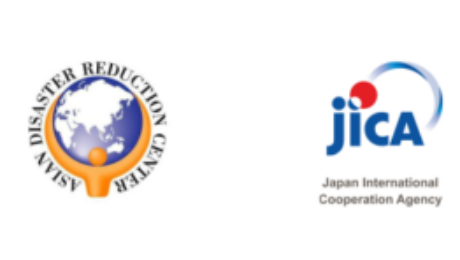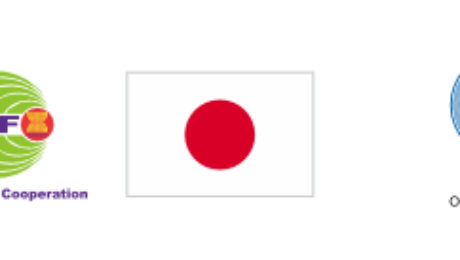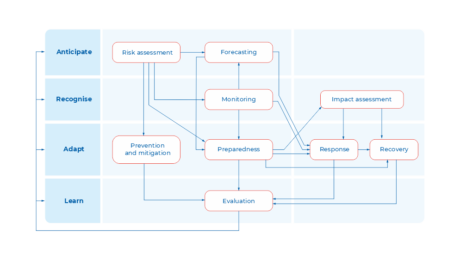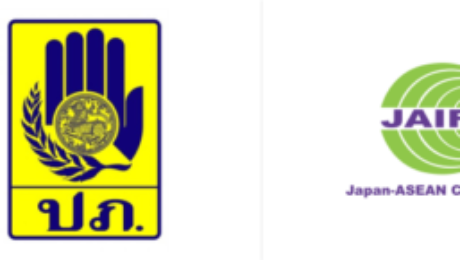Vol 86 – BUILDING A RESILIENT FUTURE: THE AHA CENTRE FORGES NEW PARTNERSHIPS WITH ADRC AND JICA

BUILDING A RESILIENT FUTURE:
THE AHA CENTRE FORGES NEW PARTNERSHIPS WITH ADRC AND JICA
In October 2023, the AHA Centre and Japan strengthened their partnership through the signing of two Memorandums of Intent (MoIs) with the Asian Disaster Reduction Centre (ADRC) in Kobe, Japan, and the Japan International Cooperation Agency (JICA).
The two MoIs were established to promote, facilitate, and strengthen regional and international cooperation in the field of disaster risk reduction and emergency response. Executive Director of the AHA Centre, Mr. Lee Yam Ming, Executive Director of ADRC Mr. SASAHARA Akio, and JICA Chief Representative to ASEAN Mr. YASUI Takehiro participated in the Signing Ceremony held in Ha Long, Viet Nam at the 19th Meeting of the AHA Centre Governing Board.
The event was witnessed by Minister of Agriculture and Rural Development H.E. Le Minh Hoan, Deputy Secretary General of ASEAN for ASEAN Socio-cultural Community H.E. Ekkaphab Phanthavong, Parliamentary Vice-Minister of Foreign Affairs of Japan H.E. HORII Manabu, and Members of the AHA Centre Governing Board.
The AHA Centre and ADRC have agreed to promote cooperation in the areas of disaster risk reduction and emergency response, enhancement of the qualifications of ASEAN experts and specialists, and the facilitation of learning and exchange between interregional organisations. Moreover, this agreement aims to introduce innovative information and communication systems in monitoring, prevention, and assessment of disaster risks in ASEAN.
Meanwhile, the AHA Centre’s cooperation with JICA will focus on promoting effective emergency response preparedness and prevention. This includes areas such as strengthening of AHA Centre capacity including in disaster information management, improvement of AHA Centre training programmes (e.g. ASEAN-ERAT courses), and the promotion of knowledge and experience sharing in disaster management. To ensure the implementation of this collaboration, a JICA team expert will be deployed to the AHA Centre.
The joint collaboration between the AHA Centre, ADRC, and JICA marks an important milestone in the 50 years of ASEAN-Japan friendship and cooperation. Not only that, but it also sets a model for interregional partnership to tackle global challenges in disaster management. With the enduring support of Japan, AHA Centre and ASEAN Member States are positioned to enhance the region’s disaster response capabilities, towards a safer, more resilient ASEAN.

Written by: Gladys Respati | Photos by: AHA Centre
- Published in Partnership
Vol 85 – SDC’S SUPPORT TO THE AHA CENTRE: ENHANCING CAPACITIES OF THE AMS AND AHA CENTRE THROUGH THE SECONDMENT PROGRAMME

SDC’S SUPPORT TO THE AHA CENTRE:
ENHANCING CAPACITIES OF THE AMS AND AHA CENTRE THROUGH THE SECONDMENT PROGRAMME
The Swiss Agency for Development and Cooperation (SDC) has been a steadfast supporter of the AHA Centre since 2017. In the first collaboration, SDC and the Global Initiative on Disaster Risk Management (GIDRM) supported preparations for the 2018 ARDEX, in particular by deploying experts to support scenario development and referee training. Following the success of this initial collaboration, SDC and the AHA Centre then signed a new Memorandum of Intent (MoI) that is much broader in scope.
Phase I of the collaboration was implemented in 2020-2021. Despite challenges posed by the COVID-19 pandemic, the commitment between SDC and the AHA Centre to enhance collaboration remained strong. This led to the continuation of the second phase of the MoI, with covered a longer period in order to achieve more strategic objectives and allow greater flexibility in implementing activities.
The MoI for the second phase was signed during the ASEAN Ministerial Meeting on Disaster Management (AMMDM) on 2 August 2019 in Bangkok, Thailand. This MoI outlined a two-year collaboration between the AHA Centre and SDC, spanning from 2022 to 2024. One of the components in this collaboration is capacity development through the implementation of a secondment programme for the ASEAN Member States and AHA Centre staff.
The secondment programme has two main objectives. First, to support the capacity development of both National Disaster Management Organisations (NDMOs) and AHA Centre staff, particularly on disaster monitoring and analysis. This capacity development will be achieved through an increased understanding and better awareness of the operational mechanisms in both the AHA Centre and the NDMOs for monitoring and analysing disasters and hazards. The second objective is to create better operational working relationships between the AHA Centre and the NDMOs, through increased familiarity with each other’s operational structures.
This programme, set to continue until 2024, allows the AHA Centre to support four secondments from NDMOs to the AHA Centre annually, as well as four secondments from the AHA Centre to the NDMOs, for a maximum duration of two weeks each.
The first batch of the secondment programme was conducted on 16-27 October 2023, with participation from six NDMO staff coming from Cambodia, Lao PDR, Malaysia, and Viet Nam. During this programme, the secondees worked together with Jakarta-based AHA Centre staff, in the Disaster Monitoring and Analysis (DMA) and Preparedness and Response (P&R) Units. They also had the opportunity to visit the ASEAN Secretariat and the Emergency Operations Centre (EOC) of BNPB Indonesia.
Beyond the secondment programme, the collaboration also includes several activities, including other capacity building programmes. All activities under this collaboration will contribute to the implementation of the AADMER Work Programme 2021-2025 and the AHA Centre Work Plan 2025.
Written by: Moch Syifa | Photos by: AHA Centre
- Published in Partnership
Vol 83 – STRENGTHENING ASEAN’S DISASTER RESPONSE THROUGH DELSA PHASE IV

STRENGTHENING ASEAN’S DISASTER RESPONSE THROUGH DELSA PHASE IV
Launched in December 2012, the Disaster Emergency Logistics System for ASEAN (DELSA) project facilitates swift provision of relief items to affected ASEAN Member States (AMS). Supported by the Government of Japan through the Japan-ASEAN Integration Fund (JAIF), the project has played a critical role in ASEAN responses over the years as a beacon of ASEAN solidarity, enabling ASEAN to provide needs-based assistance in a timely manner through prepositioned stockpiles located in the DELSA warehouses. The project’s importance was particularly felt during DELSA Phase III, where it supported multiple emergency responses in ASEAN, including Tropical Cyclone NORU in Lao PDR and Thailand, and Tropical Cyclone NALGAE in the Philippines in 2022.
In March 2023, the Phase III the ASEAN Disaster Emergency Logistics System (DELSA) was officially concluded. The project’s focus is now moving toward enhancing the sustainability of the DELSA warehouses in Malaysia, the Philippines, and Thailand, and further integrating Information and Communication Technology (ICT) to bolster regional emergency supply chain management.
OBJECTIVE:
Further enhance the supply chain management for emergency response of ASEAN to ensure timely response to disasters through:
• Prepositioning of stockpiles in 3 DELSA warehouses
• Innovation
• Utilisation of technology
• Capacity development
INDICATORS:
• The Emergency Telecommunication Network (ETN) is established;
• The ASEAN Logistics Roadmap updated for 2025;
• Procurement of stockpiles for the DELSA warehouses in Malaysia, the Philippines and Thailand;
• Capacity development / trainings for the Logistics Officers of the NDMOs of 10 ASEAN Member States
The DELSA Phase IV project is aligned with the ASEAN Agreement on Disaster Management (AADMER) Work Programme (AWP) 2021-2025 Priority Programme 3 on Preparedness and Response. More specifically, it aligns with Sub-Priority 3.2., which seeks to strengthen capacity building for effective regional response, contributing to the strengthening of regional humanitarian supply chain management, the development of a reliable Emergency Telecommunication Network to support ASEAN response, and the enhancement of assessment capabilities for a robust information management system and interoperable network of ASEAN Emergency Operations Centres (EOCs).
Furthermore, the project will contribute to the implementation of the ASEAN Outlook on the Indo-Pacific, particularly in the area of “Climate Change and Disaster Risk Reduction and Management” under the broad range area of “Economic and Other Possible Areas of Cooperation”, and the principle of “complementarity with existing cooperation frameworks”.
The future of DELSA will continue to blend technology, strategic planning, and continuous capacity building to achieve speed, scae, and solidarity in ASEAN’s collective response to disasters, in line with the spirit of One ASEAN One Response.

Written by: Gladys Respati | Photo by: AHA Centre
- Published in Partnership
Vol 84 – STRENGTHENING THE INSTITUTIONAL CAPACITY OF THE AHA CENTRE FOR ASEAN DISASTER CAPACITY BUILDING PROGRAMMES

STRENGTHENING THE INSTITUTIONAL CAPACITY OF THE AHA CENTRE FOR ASEAN DISASTER CAPACITY BUILDING PROGRAMMES
AHA Centre Work Plan 2025 envisions AHA Centre as an enabler for ASEAN to become a global leader in disaster management by 2025.
The ASEAN Vision 2025 on Disaster Management also outlines the expectations of ASEAN Member States for AHA Centre to “play a stronger role in facilitating capacity building to bring ASEAN Member States to regionally and globally recognized standards” as well as identifying AHA Centre’s potential to become “the network coordinator for regional centres for excellence for training and leadership in disaster management and emergency response and the engagement of the regional policy community” to nurture the next generation of leaders and thought leadership in ASEAN.
On 23 June 2022, Executive Director of AHA Centre, Lee Yam Ming and Ambassador of New Zealand to ASEAN, H.E. Stuart Donald Cave Calman launched AHA Centre’s partnership with New Zealand with a project titled “Strengthening the Institutional Capacity of the AHA Centre for ASEAN Disaster Capacity Building Programmes”. The partnership will focus on strengthening AHA Centre’s institutional capacity to provide world-class disaster management courses and capacity building programmes.
The 1st Project Steering Committee (PSC) Meeting was conducted online on 10 April 2023 to update the PSC members on the progress of the project. This included updates on impact study, roadmap, and Learning Management System (LMS).
IMPACT STUDY
Assessing the impact of the previous and existing ASEAN’s capacity building programmes on ASEAN and ASEAN Member Sates capacity and to evaluate the sustainability of the the impacts
ROADMAP
Will serve a comprehensive, concrete, and practical strategy for enhcancing ASEAN and ASEAN Member States capacities on disaster management for the period of 2023 – 2033
LMS
To maximise the impact and widen the coverage of the AHA Centre’s knowledge and outreach
Written by: Moch Syifa
- Published in Partnership
Vol 82 – BUILDING RESILIENCE OF WOMEN AND OTHER VULNERABLE GROUPS THROUGH CAPACITY BUILDING

BUILDING RESILIENCE
OF WOMEN AND OTHER VULNERABLE GROUPS THROUGH CAPACITY BUILDING
Background of the Project
The project ‘Improving ASEAN’s Humanitarian Assistance Capacity in Multi Hazard’ – funded by the Government of Canada (Global Affairs’ Canada) – launched in April 2022, will run for five years, from 2022 – 2027.
One of the guiding principles of the ASEAN Agreement on Disaster Management and Emergency Response (AADMER) Work Programme 2021 – 2025 is on Gender and Inclusion. This principle inculcates a whole-of-society approach in disaster management that leaves no one behind by recognizing the key roles and unique needs of the communities, especially those that are most affected during disasters, including women and other vulnerable groups. As one of the implementors of the AADMER Work Programme 2021 – 2025, the AHA Centre proposed this project to further expand the capacity of ASEAN Member States and Local Partners through a multi-sectoral approach to systematically integrate such gender and protection considerations into disaster management.
Through this project, the AHA Centre supports ASEAN Member States and Local Partners to recognize and set the priorities for indicators and targets related to protection, gender, and inclusiveness (PGI). This project believes that building resilience of women, and other vulnerable groups within the national and regional resilience will help in addressing and mitigating socio-economic impact of the disasters.
The Project adopts the AADMER Work Programme 2021-2025 and formulized the ASEAN Regional Framework on Protection, Gender, and Inclusion in the ASEAN Region. Subsequently, a new AADMER Technical Working Group on Protection, Gender, and Inclusion (TWG-PGI) was established in 2021 to support the mainstreaming of the gender and social inclusion guiding principles throughout the disaster management efforts in the region.
Main Components of the Project
The Project has three main components, among others, (i) Enhanced Regional Coordination Mechanism to respond to multiple types of disasters, which integrates PGI, Climate Change Adaptation and Environmental Sustainability measures; (ii) Improved Knowledge of ASEAN responders in addressing the needs and interests of vulnerable groups during emergency periods; and (iii) Improved disaster management and emergency response practices in ASEAN Member States.
Upcoming activities of 2023
As of February 2023,
the Canada Project had its first series of activities—Exchange Forum on ASEAN’s Practices on Data Disaggregation in Disaster Management: A Way Towards Protection, Gender, and Inclusiveness (PGI), and the 1st Project Steering Committee (PSC) Meeting of the Project, which were held in Da Nang, Viet Nam on 22-24 February 2023. The PGI Exchange Forum is designed to help participants exchange knowledge on PGI experiences, which will be a key principle for the achievement of this project. The PGI Exchange Forum and the 1st PSC Meeting were held back-to-back with the 5th Meeting of the Technical Working Group on Protection, Gender and Inclusion (TWG-PGI), and 5th Meeting of the ASEAN Committee on Disaster Management Working Group on Prevention and Mitigation (ACDM WG P&M).
Starting Quarter 2 of 2023 (April – June),
the project aims to conduct Consultation and Desk Review on expanding the existing New Risk Scenario. This activity falls under the outcome of “Enhancing Regional Coordination Mechanism to respond to multiple types of disaster which integrates PGI, Climate Change Adaptation and Sustainability measures”. Within this activity, the project aims to develop a new Disaster Risk Scenario Study, adding to the three existing scenarios in the ASEAN Joint Disaster Response Plan (AJDRP). The new Disaster Risk Scenario will focus on Transboundary Flood within the Mekong sub-region. Additionally, the scenario will integrate PGI, Climate Change Adaptation and Environmental Sustainability as part of the Project’s key thematic areas.
In Quarter 3 of 2023 (July – August),
the project intends to organize consultation workshops to validate the New Risk Scenario. Within the same quarter, the project further aims to conduct Capacity Building on PGI, focusing on the exchange of experiences among ASEAN Member States through cross-learning.
In the last Quarter 4 of 2024 (October – December),
the project aims to deploy experts from the Member States to other Member States as part of Capacity Development Support.
Canada’s Support
The Project Management Team has been recruited in Jakarta, Indonesia, and have begun their work alongside the Disaster Monitoring & Analysis Team (DMA) in the AHA Centre. The Team is currently made up of a Project Officer and Project Assistant, who will implement the project’s activities and strategy with support from the Government of Canada and experts from the AHA Centre’s partners, including UNWOMEN, LACER, and SDC.
This forms an exciting journey for the AHA Centre and the ASEAN Member States to ensure this initiative further contributes to the envisions of AADMER Work Programme 2021-2025. The AHA Centre, through the Canada-funded project, looks forward to working closely with the Government of Canada, NDMOs, ASEAN Member States, The ASEAN Secretariat, and AHA Centre partners, to integrate PGI, CCA, and ES into the efforts of increasing capacity, enhancing standby arrangement with new disaster scenario, and further increasing collaboration and partnership will increase resiliency of multiple types of disasters within AMS and Local Partners.
Written by: Pwint Mon Swe, Htet Wai Zin, Lawrence Anthony Dimailig
- Published in Partnership
Vol 81 – LACER INTRODUCES A STRATEGIC TOOL FOR ENHANCING DISASTER MANAGEMENT IN THE AHA CENTRE AND BEYOND

LACER INTRODUCES A STRATEGIC TOOL FOR ENHANCING DISASTER MANAGEMENT IN THE AHA CENTRE AND BEYOND
The EU-funded LACER project aims to sharpen procedures for strategic planning and programming in ASEAN´s disaster management capacities. The disaster risk management (DRM) tool used by LACER is intended to support the elaboration of plans for capacity development projects and to assess the strengths and weaknesses of DRM systems in any part of the world. Peter Månsson, after obtaining a PhD in disaster risk management, was recruited to the project in 2021, bringing with him the methodology originally developed at Lund University and subsequently adopted by the Swedish Civil Contingencies Agency (MSB).
Aside from assessing the disaster management capacities of the AHA Centre, the tool can support the mapping of external support and the existing institutional framework. Moreover, it may be used for assessing and comparing disaster management capabilities of ASEAN Member States. Such an overview would enable the AHA Centre to guide the Member States toward developing specific disaster management abilities. This would not only benefit members but allow the AHA Centre to play a pivotal role as a mediator of cross-border collaboration and peer-to-peer learning, while strengthening disaster management capabilities across the region.
Figure 1. Key functions of DRM-systems and some of their interdependencies
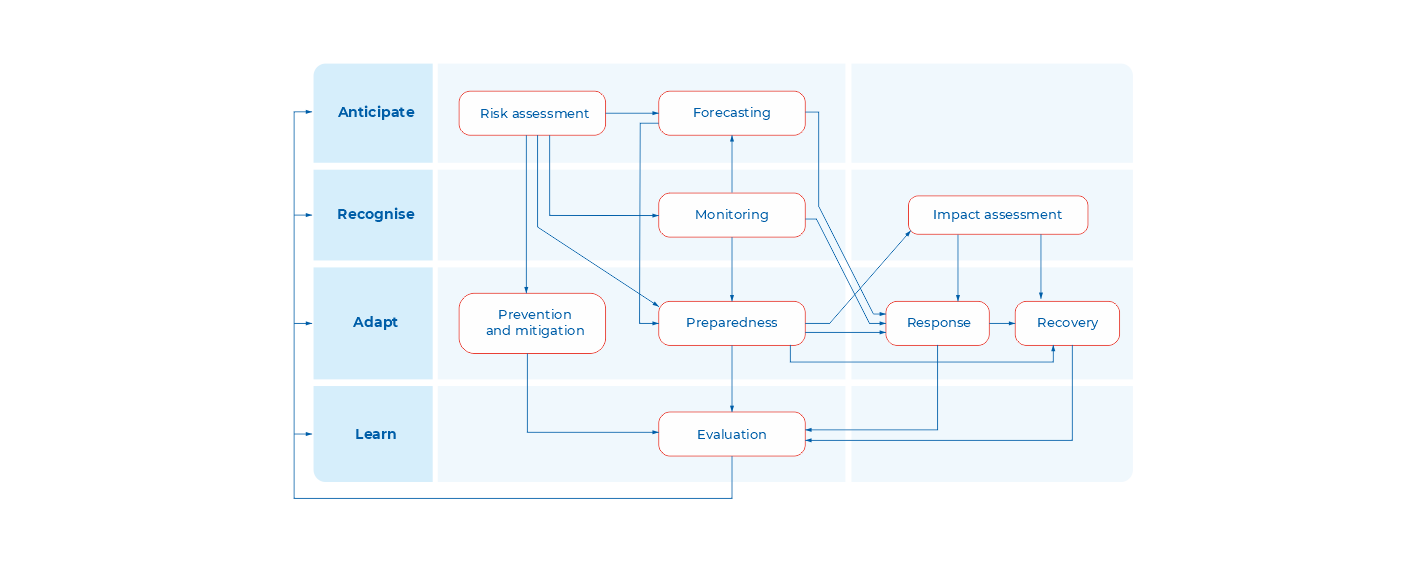
Protecting human values and learning from disasters
The DRM tool is a refinement of a method for assessing community resilience, which further builds on an established theory of resilience engineering and the four cornerstones of resilience.1
The purpose of DRM systems is to protect what human beings value and, to achieve that, the systems need to anticipate, recognize, adapt to and learn from disasters and other types of disturbances to societal safety. DRM systems need to be able to perform a set of functions where anticipation is ensured through the functions of risk assessment and forecasting. To recognize when disasters are about to occur, or have happened, we need the functions of monitoring and impact assessments. To adapt societies to safeguard what humans value, we utilize the proactive functions of prevention/mitigation and preparedness as well as the reactive functions of response and recovery. Finally, to continuously learn and develop safer societies, we need the function of evaluation to enhance the impact of DRM systems.
These functions are not only vital in themselves, but also dependent on each other in such a way that the performance of one function requires the output from another function, e.g. to warn the public to take shelter against a coming cyclone necessitates information from forecasting or weather monitoring.
Figure 3. Column type graphs are useful for comparing various organizations and realize who may learn from whom relative to these functions.
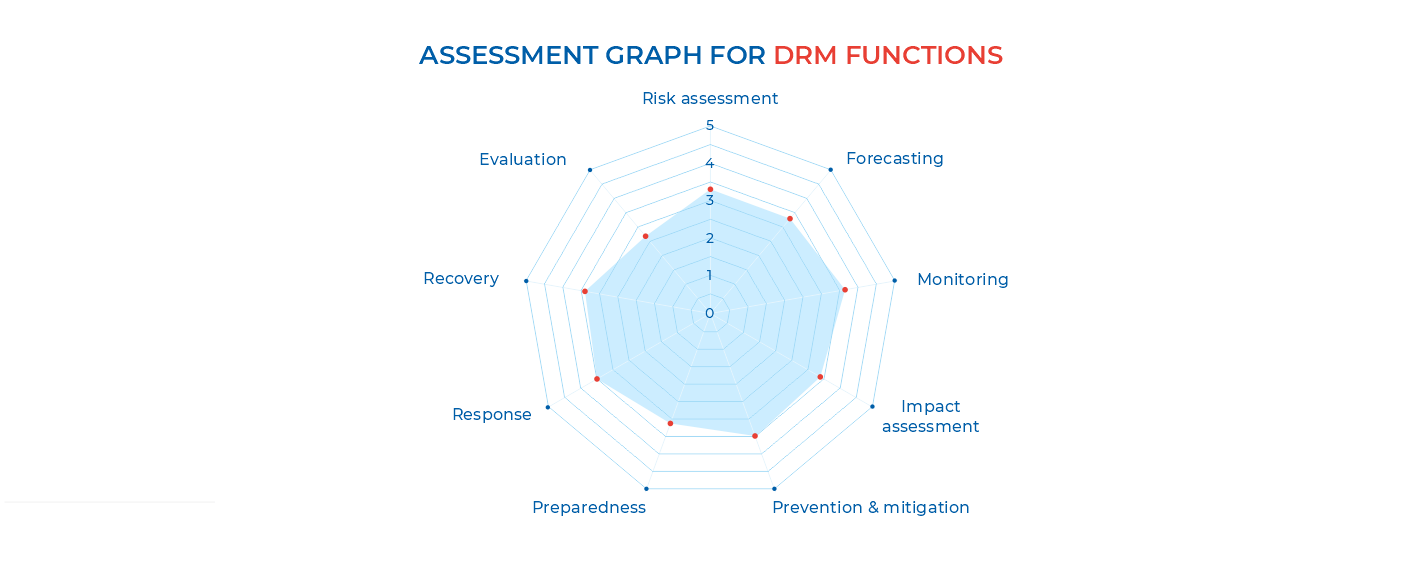
Using the tool for capacity assessments
While these functions are general for all DRM systems in the world, the specifics of how they are implemented, by who and with what resources vary greatly from country to country. Assessing the capacity to perform each function in a specific country entails analyzing what actually exists in that context in order for each function to work. To do this in the ASEAN context, the LACER project developed a survey that contains a number of statements related to these factors, which need to be assessed for each function for a comprehensive analysis of capacities of the DRM system. The results of the survey may be visualized with the help of a “spider graph”, which shows where the prerequisites for performing the functions are adequate or may be improved (Fig. 2). The traceability of the tool enables the user to identify which aspects are judged to be substandard and need to be developed in order to enhance the performance of a specific function.
In addition, the tool may be used to compare assessments of different organizations with each other. For example, assessments of various national disaster management organizations (NDMOs) may reveal who can learn from others regarding a specific DRM function. Such an overview could provide the AHA Centre a means for instigating and facilitating cross-border collaboration in support of proactive disaster management to the benefit of the region at large.
Yet, graphs of ten different NDMOs would make a spider chart cluttered and the information hard to distinguish. Hence, for comparisons across organizations it is better to use one chart per function and bar graphs, where the NDMOs are shown as different columns on the x-axis and their capabilities on the y-axis (see Fig. 3).
Figure 3. Column type graphs are useful for comparing various organizations and realize who may learn from whom relative to these functions.
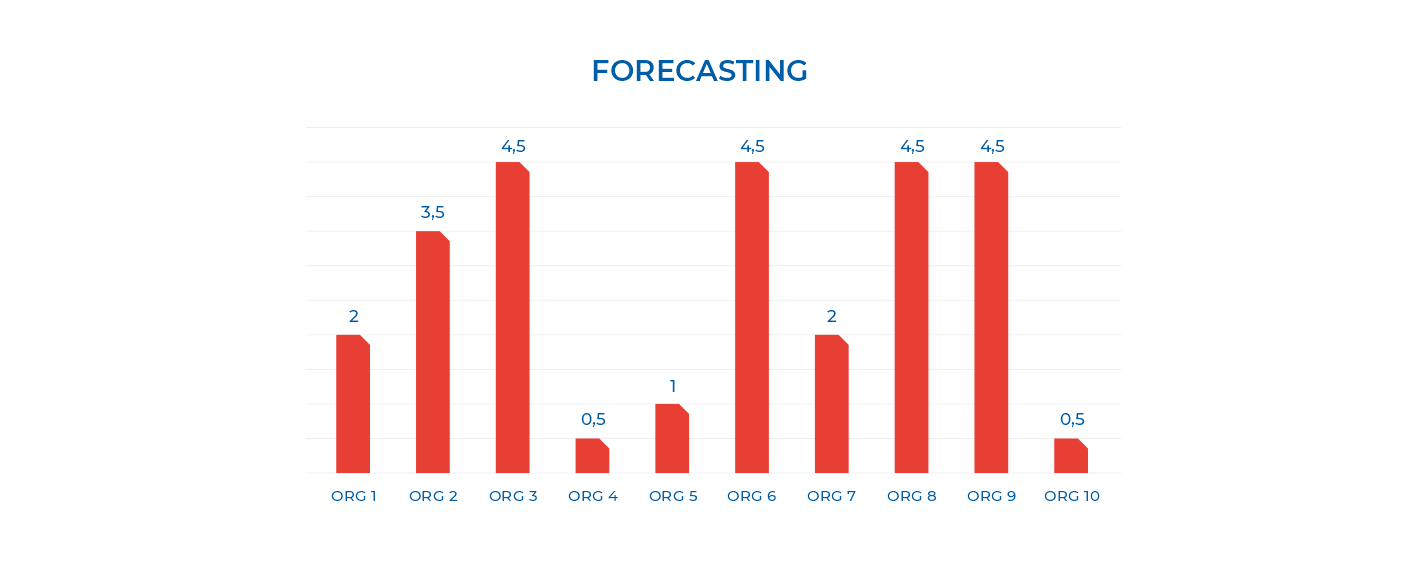
Using the tool for mapping institutional frameworks and donor support
During the fall of 2021, the tool was used by the LACER project for two additional purposes: to attain overviews of 1) the institutional framework of the AHA Centre and 2) the support it receives from external partners.
In the first case, legislative requirements, guidelines and standard operating procedures of the AHA Centre and the EU Civil Protection Mechanism were compared. In the latter case, the tool was used to analyze all support received by the AHA Centre from external agencies and donors, by looking through the lens of capability for each function.
Importantly, the AHA Centre receives support from 31 external agencies. The results, however, suggest that external support is unevenly distributed over the functions, with certain functions such as Preparedness, Response and Recovery receiving the lion´s share of support and interest from external funders whilst other functions such as forecasting and impact assessment receive little attention. Since the nine general functions are mutually dependent, it makes sense for a DRM organization pursuing a balanced approach in terms of institutional frameworks and support from external partners. Depending on the outputs of capacity assessments, an organization may opt to seek greater external support for some particular functions. Such imbalances, however, should be based on thorough assessments and conscious strategic decisions rather than ad hoc opportunities for funding.
Having a sound understanding of one’s own deficiencies and development needs shows strategic depth and indicates the presence of a serious partner that has a clear idea about which capabilities need to be addressed to become an even stronger player in the field of disaster management. The tool described here is a means to this end.

1 The theoretical basis of the tool is described in Becker, P., Abrahamsson, M., & Tehler, H. (2014). An emergent means to assurgent ends: Societal resilience for safety and sustainability. In C. P. Nemeth, & E. Hollnagel (Eds.), Resilience Engineering in Practice, Volume 2: Becoming Resilient (pp. 1-12). Boca Raton: CRC Press.
Written by: Dr. Peter Månsson, LACER Organisational Development Expert.
- Published in Partnership
Vol 80 – THE DELSA SATELLITE WAREHOUSE IN CHAINAT, THAILAND: A SYMBOL OF COLLABORATION IN DISASTER RESPONSE

THE DELSA SATELLITE WAREHOUSE IN CHAINAT, THAILAND:
A SYMBOL OF COLLABORATION IN DISASTER RESPONSE
More than two years have passed since the DELSA Satellite Warehouse in Chainat Province, Thailand, was launched in December 2019.
As part of the Disaster Emergency Logistics System for ASEAN (DELSA), the warehouse was designed to increase the speed and scale of ASEAN’s collective response in the region, mainly in Cambodia, Lao PDR, Myanmar, Thailand, and Viet Nam, and is equipped with international-standard stockpiles adjusted to ASEAN needs. It also complements the existing regional reserves stored at the DELSA Regional Stockpile located within the compound of the United Nations Humanitarian Response Depot (UNHRD) in Subang, Malaysia, and the DELSA sister satellite warehouse located in Camp Aguinaldo, the Philippines that was launched in July 2019.
Relief items stored at the Chainat warehouse range from kits to be distributed to disaster-affected communities, to vital equipment needed to support on-the-ground operations of the National Disaster Management Organisations (NDMOs) of affected countries and the ASEAN Emergency Response and Assessment Team (ASEAN-ERAT).
Since its inauguration, the DELSA Satellite Warehouse in Chainat has continued to serve as the central logistics hub for the Mekong subregion. From June 2020 – December 2021, the warehouse deployed 2,900 Personal Hygiene Kits (PHK) to the National Committee for Disaster Management (NCDM) of Cambodia, and 2,100 personal hygiene kits and 50 Family Tents to the Department of Disaster Prevention and Mitigation (DDPM) of Thailand, to support the ongoing COVID-19 response in both countries.
Key to the successful operationalisation of the DELSA Satellite Warehouse are the partnerships forged between the AHA Centre, as the primary regional coordinating agency in disaster management within the ASEAN region, and the many countries and institutions with concern for the issue of disaster management and response.
The warehouse was built with the support of the Government of Japan through the Japan-ASEAN Integration Fund (JAIF) and the Ministry of Interior of Thailand to the DELSA project, while its stockpiles are sourced from the contributions of the ASEAN Member States and the AHA Centre’s partners, both public and private sector. In terms of management, the warehouse is co-managed by DDPM Thailand and the AHA Centre. The Memorandum of Understanding (MoU) between the AHA Centre and DDPM was signed on Thailand for the establishment of the satellite warehouse in Chainat, Thailand, to house the ASEAN stockpile for immediate deployment in the nearby region.
The AHA Centre will continue to foster meaningful regional and global partnerships to achieve an envisioned fully-integrated regional warehouse system that enables faster response, greater resource mobilisation, and stronger coordination in collective response to disasters in line with the Roadmap for Enhancing ASEAN Emergency Logistics.

Written by : Gladys Respati | Photo Credit : AHA Centre
- Published in Partnership
Vol 79 – UN WOMEN: STRENGTHENING GENDER-RESPONSIVE DISASTER MANAGEMENT

UN WOMEN:
STRENGTHENING GENDER-RESPONSIVE DISASTER MANAGEMENT
Recognizing that gender mainstreaming is important in disaster management, the AHA Centre has partnered in the past years with the United Nations Entity for Gender Equality and the Empowerment of Women, or UN Women. A global champion for gender equality, UN Women was established to accelerate progress on women’s and girl’s rights worldwide. Alongside other United Nations partners, UN Women’s collaborations with the AHA Centre fall under the ASEAN-UN Joint Strategic Plan of Action on Disaster Management (JSPADM).
With the adoption of the ASEAN Agreement on Disaster Management and Emergency Response Work Programme 2021-2025, ASEAN has taken gender and social inclusion as a guiding principle for the implementation of all its disaster management work. Through an ECHO-funded programme called “Strengthening Gender-Responsive Disaster Management in ASEAN,” UN Women works in close collaboration with the ASEAN Secretariat and the Technical Working Group on Protection, Gender, and Inclusion, of which the AHA Centre is a key member, to support operationalization of this guiding principle.
The AHA Centre and UN Women have partnered to provide disaster management actors in the region with capacity strengthening on gender and social inclusion, Alongside sister agencies UNFPA and UNICEF, UN Women has delivered courses to officials from ASEAN national disaster management organizations on rapid assessments for women and children. UN Women and UNFPA also contribute to AHA Centre initiatives such as the Humanitarian Emergency Logistics Innovation Expo (HELiX) through organizing dialogues on accountability in humanitarian logistics, and providing key “musts” for hackathon participants to consider in their solutions to not widen the gender digital gap.
Building on ASEAN momentum in strengthening risk governance to become more responsive to the needs of women, girls, and marginalized groups, UN Women emphasizes the critical importance of also recognizing their roles as leaders and agents of change in disaster management. The launch of the ASEAN Regional Framework on Protection, Gender, and Inclusion in Disaster Management 2021-2025 in October 2021 marked a key step forward in this. The AHA Centre continues to have a key role to play in operationalizing target actions including for the leadership of those most impacted by disasters. For example, the ASEAN Disaster Resilience Outlook notes that women only form 25% of regional Emergency Response and Assessment Team trainers and members, even though women make up 50.1% of the ASEAN population – partnerships with organizations like UN Women can support in creating enabling environments for increasing not only the number of women on teams, but also their influence and voice.
With strong policies and strengthened capacities and understanding on gender, the next step is to implement the frameworks into concrete actions. Substantive progress has already been made to better understand the impacts of disasters on those most vulnerable. Moving forward, supporting and resourcing women’s organizations and gender machineries in the ASEAN region which have contributed to the gender-responsive disaster risk reduction is key.
As the AHA Centre enters its second decade of operations, it will continue to draw upon and exchange experiences with UN Women on gender-responsive disaster management and response, contributing to a more equal, resilient region for all.
Written by : Judith Garcia Meese | Photo Credit : Doc. UN Women
- Published in Partnership
Vol 78 – AHACKATHON: BUILDING PARTNERSHIP IN INNOVATION AND TECHNOLOGY

AHACKATHON:
BUILDING PARTNERSHIP IN INNOVATION AND TECHNOLOGY
Constructive engagement and networking with partners are among the key strengths of the AHA Centre.
A strong example of this can be found in the recent staging of the AHAckathon app design and programming competition in October, a component of the Humanitarian Emergency Logistics Innovation Expo (HELiX) held in May this year, organised by the AHA Centre and the Viet Nam Disaster Management Agency.The AHAckathon united more than 50 participants in seven teams from 11 countries from ASEAN and beyond in fostering new innovative ideas and solving contemporary challenges in the field of humanitarian logistics and disaster management. Key to the success of this competition was the partnership between the AHA Centre and Impact Week, a non-profit organisation and programme dedicated to promoting innovation and entrepreneurship through the concept of Design Thinking.
Impact Week has been running similar events to the AHAckathon since 2015 with over 2,000 students involved in the past, and Impact Week’s latest partnership with the AHA Centre was brought about through mutual partnership with HELP Logistics, another longtime network of the AHA Centre and sponsor of Impact Week Jordan 2019.
As has been the case with many organisations, the pandemic in 2020 necessitated transition to virtual events, including HELiX itself and the AHAckathon. Impact Week’s expertise was crucial in this successful transition and the execution of the AHAckathon as a fully virtual event. Furthermore, the AHAckathon was special both because of its focus as an app programming competition, and the next-level integration of the Discord messaging software and MURAL collaborative design board as the platform for the competition – an aspect consistently praised by the participants, alongside the learning experience with humanitarian-logistics and disaster-management experts. In this regard, the execution of the AHAckathon as a fully-online event was also further enhanced by the usage of launchlabs’ Berlin virtual studio and green screen, a key technical implementation by Impact Week and launchlabs, which resulted in the online event’s top-class professional quality streaming and recording.
Another key contribution and support from Impact Week in the AHAckathon’s execution was the steadfast and circumspect guidance of the coaches in guiding the participant teams through the Design Thinking approach to systematically reframe and conceptualise the challenges in the competition, enabling them to truly develop and implement their innovative ideas into working app prototypes aimed at solving the relevant issues and needs present in the field of humanitarian logistics.
In conclusion, with its fruitful discussions, ideas and engagement with partners, the AHAckathon has been a constructive experience and example of the strengths of innovation and cooperation; key aspects that will certainly shape the next steps of the AHA Centre especially as it entered its 10th anniversary in November this year.
Written by : Yohanes Paulus, DELSA Programme Assistant | Photo Credits: AHA Centre and Michael Koegel
- Published in Partnership
Vol 77 – LAUNCHLABS

LAUNCHLABS
The AHA Centre recently held the AHAckathon Competition, where several teams from different countries worked on developing a mobile app to find solutions in disaster management. The exciting three-day event would not have been possible without the help of partners like launchlabs.
Innovation consultant Tobias Wosowiecki explained what launchlabs is all about. “What launchlabs is doing is all around innovation and also around cultural change. The world is becoming more and more complex. We are helping clients and organisations act like successful start-ups, which means they are really agile and flexible as they are changing the culture. And how they are changing their solutions, like when they are getting information from end-users. We are doing that with the approach of agile frameworks, like design thinking, scrum, lean start-up.”
For this approach, launchlabs has three pillars. “The first pillar is called learninglabs, where the teams will learn to understand and apply methods for human-centered and agile innovation development, enabling them to develop new products, services or business models that their customers really need in a playful and risk-free manner” said Tobias, or Toby to his friends and colleagues.
The second pillar is called projectlabs, where clients change the way they approach complex strategic and innovation project without a clear solution path. Launchlabs facilitates and enables the entire innovation process as experts for agile work from the first planning session all the way to implementation. “We are helping people to create their own ideas. This is our main work.
And with that we are using different kinds of frameworks, like what we did with the AHAckathon. At the end of a specific time, we come up with prototypes that we can test and implement in the system,” he said.
The third pillar is called culturelabs, which is all about building a sustainable agile corporate culture. “The culture needs to grow and change sometimes. We are helping our clients create and design agile work environments. Especially now that we’re going through a pandemic. We’re creating virtual working environments. All of that means change. In this kind of field, we become more like coaches. And all of this needs communication. That is the underlying theme of these three pillars.”
Launchlabs partnered with the AHA Centre for the HELiX AHAckathon Competition. The challenge of using technology to find solutions for disaster management was posed to students from different countries of the ASEAN region. “Before you can start a hackathon, you need a problem. This is what we created together with the AHA Centre. We created six different challenges that teams could choose from. We needed to find the right problems. Part of the pre-work was to find the right problems and frame challenges. So it’s easier to understand what the problem is, try to solve it as well, and who are the users inside it,” Toby explained.
Students from the different countries of the ASEAN region joined the three-day competition, forming teams and collaborating among themselves in coming up with the best app to solve disaster-management issues. The teams showcased past disasters in their respective countries and the solutions they came up with in the areas of logistics, emergency response, coordination and communication.
“All the teams focused on the users. That was what we tried to achieve. In this context, when we are trying to solve problems, we are not solving it for ourselves, but for other people. We are trying to understand the situation. They designed the platform but never really lost their focus on the end user.”
Being part-Indonesian, Toby understood the cultural aspects of handling, mentoring and coaching teams for the AHAckathon. “We should not lose the connection with people when looking for solutions. With my experience, when it comes to collaboration, the Asian culture is supporting it. Asia has a strong culture of working together,” he said.
“The AHA Centre does really important work. I have learned many things about disasters through this partnership. We have a better understanding of how to solve them. I think that Germany could have handled the recent disaster in a better way, which is mainly due to the fact that we are not so experienced with such disasters” said Toby, recalling the July 2021 floods that inundated parts of Germany. He notes that in Asian countries, people come together, help each other and collaborate during disasters. “I think this collaboration can really help us, especially the European collaboration with the AHA Centre. We have much to learn from Asian countries.”
“Collaboration is all that you need, collaboration is the main thing you do to provide the help. The main goal is to get the help to affected areas fast.” On his views of the role of technology in disaster management, “Technology is definitely helping us organise ourselves. But what I also believe is that we should not lose focus on people affected by these disasters, not lose the personal connection. This is the challenge we have to tackle with integrating technology more. Technology solves problems, but the people who are affected in flooded areas, they still need that human contact,” he added.
Written by : Judith Garcia Meese | Photo Credit : AHA Centre and Launchlabs
- Published in Partnership

